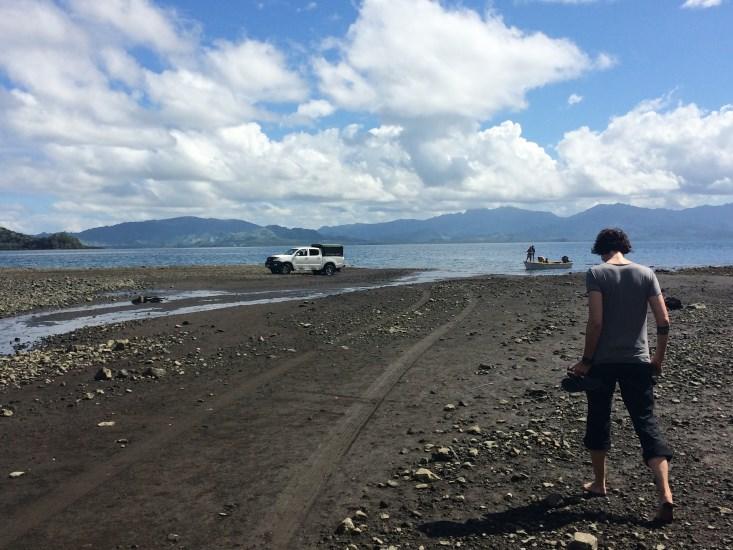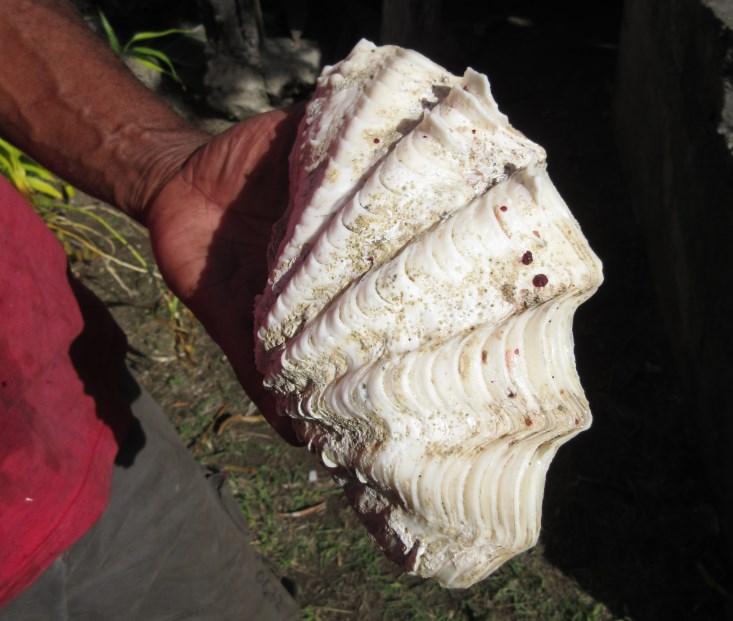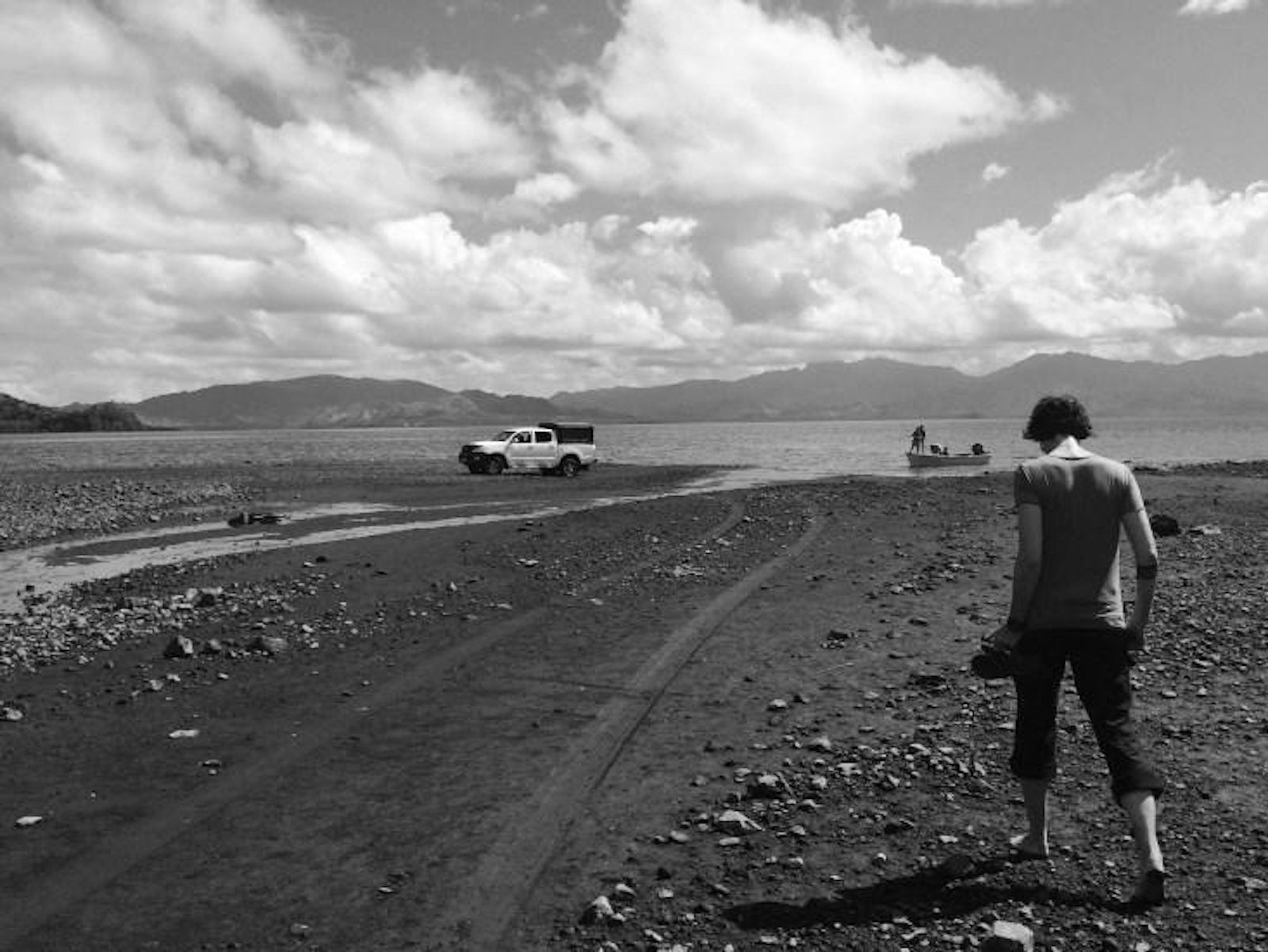I look out the windshield of the taxi and see that the road through the tropical forest ends, but our journey does not. We continue on a rutted dirt road, then ford a small stream, and eventually emerge from the thick vegetation at the edge of a vast and empty beach. Here, we wait. A great deal of doing fieldwork in Fiji is waiting. This can sometimes feel at odds with the knowledge that passing time means the continued exhaustion of marine life in the coral reefs that ring these islands.
My fellow passengers—Joshua Drew, a conservation biologist from Columbia University, and Sharyn Jones*, an anthropologist from Northern Kentucky University—look out across Natewa Bay toward the mountainous band of green that divides water and sky. On the opposite shore, at Jones’s dig, her students await the provisions in the taxi: sugar, eggs, gasoline. Jones and her students are excavating an ancient settlement of the Lapita, the first people to settle the Fijian islands, nearly 3,000 years ago. She is interested in long-term interactions between humans and the environment in Fiji and the tropical Pacific, particularly how Pacific Islanders have used and managed marine resources. Drew is visiting the site because he’s interested in what she’s found, particularly the shells her team has unearthed near ancient Lapita homes. We’re here to rifle through some 2,000-year-old trash, to see what clues it holds for conservation today.
Coral reefs are arguably the most biologically diverse ecosystems in the world, including 32 of the 33 animal phyla (according to one counting scheme), and the South Pacific holds some of the world’s last remaining coral reefs and thus some of the richest biodiversity in the world. But rising sea levels, extreme weather, ocean acidification, and overfishing are all taking a toll. In recent years, massive coral die-offs known as “bleaching events” have devastated marine ecosystems around the tropical Pacific and marine species are quickly disappearing. The species that remain are smaller and harder to find, which is bad news for Fiji, a country for which fishing and tourism are major sources of food and income. Fiji has the fastest-growing tourism industry in Oceania, which leaves its reef ecosystems especially vulnerable to the increasing activity. This has Fijians asking some of the biggest global questions in conservation today: What might we gain by trying to save “nature,” and do we have any chance of succeeding? What parts of nature should we try hardest to save, and how?

A wooden skiff powered by a questionable outboard motor arrives from across the bay, piloted by a Fijian who introduces himself as Joe. He and his two grandsons help us load the provisions onto the boat. About 20 minutes later, after a fast, wind-whipped ride and much slower navigation of a small reef of rock and brain and staghorn coral, we arrive at a long, narrow beach lined by a palm forest. Jones’s camp is just inside the edge of forest, marked by blue tarpaulins strung between palms and freshly cut bamboo poles. There is a long table with wooden benches and an open-air open central living area with palm fronds soft underfoot. One of the students tells me Joe can “make furniture out of anything,” and he has clearly been generous with his skills. The young researchers’ respect is palpable.
We cart the provisions into camp and Jones shows us around the dig site, a patchwork of perfectly even squares dug into wet earth, tracing the ghostly shapes of Lapita homes from thousands of years ago—here, the foundations of a front wall; there, the kitchen with the big serving stones, the trash out back. She pulls a Ziploc bag from a row of labeled cardboard boxes and offers Drew a treasure of ancient seashells left by the Lapita. He picks through them appreciatively, but when Jones opens another cardboard box and pulls out a giant clam about the size of a soccer ball, Drew actually gasps. He works with Fijians who still eat these clams today. Time has folded in on itself.

“It shows a pattern of millennial use,” says Drew. “These clams have been sustainably harvested for over 2,000 years, but today, those populations aren’t flourishing on their own.” Today, many Fijians live off fish and shellfish collected on the reefs, but those reef ecosystems that Fijians have relied on for centuries may not exist in another 2,000, or 200, or even 20 years. Something has to give. We all coexist with a planet aching under the weight of human use and misuse, and the islands of Fiji are the front line of the new millennium of planetary change.
Back the way we came, across the mountainous interior, over on the southern coast of Vanua Levu, Drew is doing conservation-biology fieldwork in the fishing village of Nagigi (nai-nee-nee), where the villagers are deeply concerned about diminished fish and shellfish stocks on their reef. In Nagigi, the question of what to save may be dictated, as it increasingly is elsewhere, by the demands of food security (pdf). Learning to manage marine resources that once seemed infinite may mean calling on a centuries-old cultural practice known as tabu—aided this time by conservation research from Joshua Drew’s group.
In her next report, Meehan Crist watches the residents of Nagigi, Fiji, go through the delicate process of discussing the creation of a tabu.
This reporting for this story was made possible by a grant from the Mindlin Foundation.
Correction, July 1, 2015: The post originally misspelled Sharyn Jones’s name.
Meehan Crist is writer in residence in Biological Sciences at Columbia University and editor-at-large at Nautilus. Her writing has appeared in publications such as The New York Times, The Los Angeles Times, The New Republic, The Believer, Scientific American and Science.






























